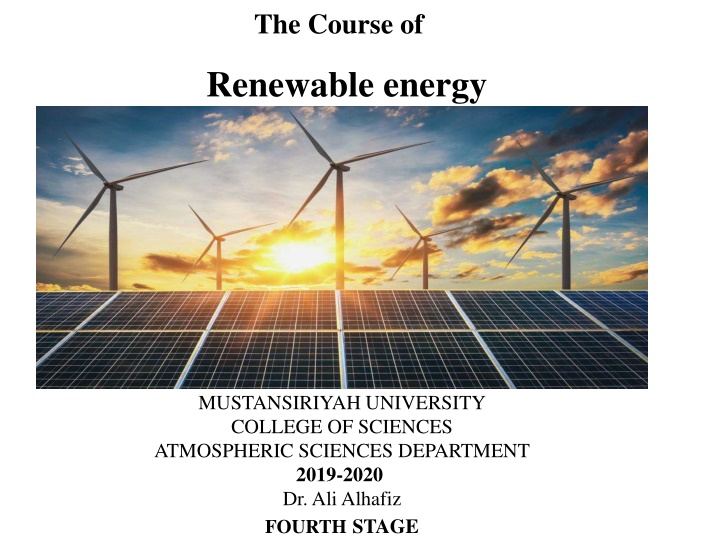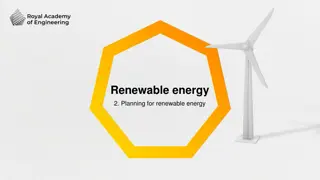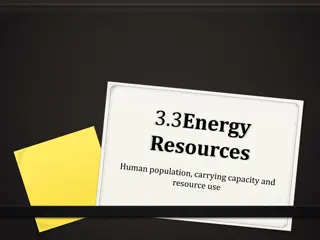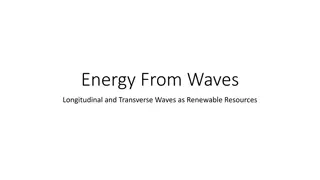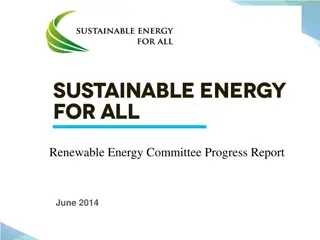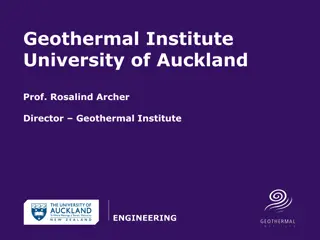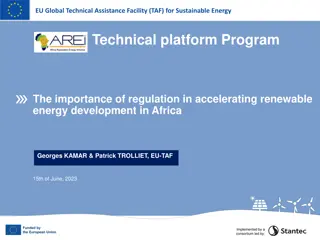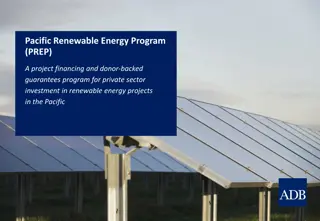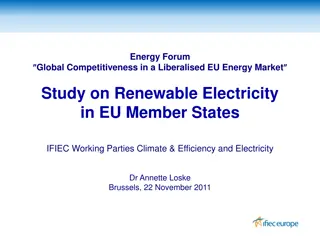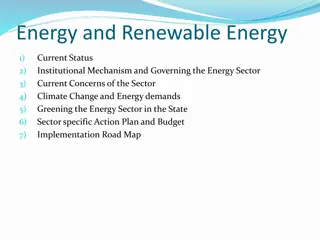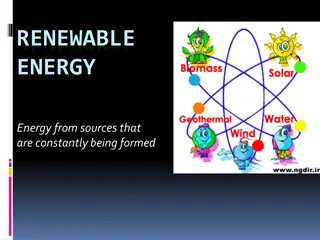Renewable energy
Renewable energy encompasses hydropower, solar, geothermal, & wind energy. Wind power calculations rely on geometry & kinetic energy physics, considering air density & velocity.
Uploaded on Feb 24, 2025 | 2 Views
Download Presentation

Please find below an Image/Link to download the presentation.
The content on the website is provided AS IS for your information and personal use only. It may not be sold, licensed, or shared on other websites without obtaining consent from the author.If you encounter any issues during the download, it is possible that the publisher has removed the file from their server.
You are allowed to download the files provided on this website for personal or commercial use, subject to the condition that they are used lawfully. All files are the property of their respective owners.
The content on the website is provided AS IS for your information and personal use only. It may not be sold, licensed, or shared on other websites without obtaining consent from the author.
E N D
Presentation Transcript
The Course of Renewable energy MUSTANSIRIYAH UNIVERSITY COLLEGE OF SCIENCES ATMOSPHERIC SCIENCES DEPARTMENT 2019-2020 Dr. Ali Alhafiz FOURTHSTAGE
Welcome Students! TO LECTURE THREE
Renewable are energy sources with unlimited amounts. These natural resources do not need to be burned in order to get energy. Examples include hydropower, solar power, geothermal power, and wind energy. Much of the electricity is created using coal and natural gas. These are natural resource found underground and are brought to the surface and burned to produce energy. There is only a limited amount of natural resources available to use for energy.
Wind is simply air in motion. It is caused by the uneven heating of the Earth's surface by the sun. Because the Earth's surface is made of very different types of land and water, it absorbs the sun's heat at different rates. Today, wind energy is mainly used to generate electricity. Wind is a renewable energy source because the wind will blow as long as the sun shines. Wind power or (energy) is the conversion of wind energy into a useful form of energy, such as electricity, using wind turbines
Calculation of Wind Energy and Power Calculating the energy (and later power) available in the wind relies on knowledge of basic geometry and the physics behind kinetic energy. The kinetic energy (KE) of an object (or collection of objects) with total mass M and velocity V is given by the expression: KE = * M * V2 Now, for purposes of finding the kinetic energy of moving air molecules (i.e.: wind), let's say one has a large air parcel with the shape of a huge hockey puck: that is, it has the geometry of a collection of air molecules passing though the plane of a wind turbines blades (which sweep out a cross-sectional area A), with thickness (D) passing through the plane over a given time. The volume (Vol) of this parcel is determined by the parcel's area multiplied by its thickness: Vol = A * D
Let (the greek letter 'rho') represent the density of the air in this parcel. Note that density is mass per volume and is expressed as: = M / Vol And a little algebra gives: M = Now let's consider how the velocity (V) of our air parcel can be expressed. If a time T is required for this parcel (of thickness D) to move through the plane of the wind turbine blades, then the parcel's velocity can be expressed as V = D / T And a little algebra gives D = V * T. * Vol
(KE = * M * V2 ) Substitute for M (= * Vol ) to obtain: KE = * ( * Vol) * V2 And Vol can be replaced by A * D to give: KE = * ( * A * D) * V2 And D can be replaced by V * T to give: KE = * ( * A * V * T) * V2 Leaving us with: KE = * * V3 * A * T Now,
Now, power is just energy divided by time, so the power available from our air parcel can be expressed as: Pwr = KE / T = ( * * V3 * A * T) / T = * * V3 And if we divide Pwr by the cross-sectional area (A) of the parcel, then we are left with the expression: Pwr / A = * * V3 Note two important things about this expression: one is that the power is proportional to the cube of the wind speed. The other is that by dividing power by the area, we have an expression on the right that is independent of the size of a wind turbines rotor. In other words, Pwr/A only depends on (1) the density of the air and (2) the wind speed. In fact, there is no dependence on size, efficiency or other characteristics of wind turbines when determining Pwr/A. The term for the quotient Pwr/A is called the "Wind Power Density" (WPD) and has units of watts/m2.
Sample exercises: 1. For a wind turbine with rotor diameter 43 meters (a typical size for a 600 kW turbine), calculate the volume and mass of a 1 meter thick parcel of air passing through the plane of the turbine blades (for this exercise, assume a value for the air density of 1.225 kg/m3). 2. Assume there is a wind blowing with a constant velocity V of 10.0 m/s through the blades of the turbine described in no. 1. What is the wind power density? (again, assume = 1.225kg/m3) 3. A smaller wind turbine which produces about 50kW has a blade rotor radius of 7 m. (14 m. diameter). Calculate WPD for this wind turbine, assuming the same conditions as given in Exercises 1 and 2.
Answers to sample exercises 1.) Ans.: The volume of this disk of air equals its cross-sectional area A ( = PI * Diameter2 ) times the disk's depth (D): Vol = * 3.1416 * (43 m)2 * 1 m = 1451 m3 . And its mass equals the volume of air times air density: M = * Vol = 1.225 kg/m3 * 1451 m3 = 1780 kg. (or ~3900 pounds - about the weight of an intermediate car!) 2.) Ans.: WPD = Pwr / A = * * V3 = * 1.225 kg/m3 * (10.0 m/s)3 = 613 watts/m2 (this is an excellent value for WPD) 3.) Ans.: Easy! Remember that WPD is independent of turbine type or size, and only depends on wind speed and density. Hence, the WPD is still 613 watts/m2 , the same as calculated in exercise no. 2.
